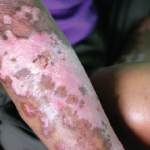Certain inflammatory mediators, such as interleukin (IL) 6, have shown promise in ongoing clinical trials. SSc patients have elevated levels of serum IL-6, and high levels of IL-6 are present in their skin lesions.18,19 IL-6 may be involved in both fibroblast activation and collagen release, and it plays a key role in the transition from innate to acquired immunity. Tocilizumab, a human monoclonal antibody against the IL-6 receptor, has shown promising results in clinical trials, says Dr. Distler. In one Phase 2, randomized, double-blind, placebo-controlled trial of subcutaneous tocilizumab, a subset of SSc patients with inflammatory, early diffuse cutaneous SSc showed improvements in many endpoints, although not all changes were statistically significant.20 A Phase 3 trial of tocilizumab is now in the recruitment phase.
B cells are also found in those inflammatory infiltrates in fibrotic skin, says Dr. Distler. The B cell-depleting CD20 antibody drug rituximab showed promise in a retrospective analysis of European League Against Rheumatism (EULAR) scleroderma trials.21 Two trials of rituximab for treatment of SSc-associated PAH and SSc-related polyarthritis are still in progress.
Antifibrotic therapies that target nuclear receptors are a newer area of interest for researchers, especially agonists of peroxisome proliferator-activated receptors (PPARs), says Dr. Distler. PPAR-γ is decreased in the fibrotic tissues of SSc patients.22 PPAR-γ agonists like thiazolidinediones may elevate low-density lipoprotein (LDL) levels. However, a pan-PPAR agonist, IVA337, did not raise LDL levels and shows antifibrotic effects in preclinical models of SSc and is in a trial for diffuse cutaneous SSc now, he says.23
Stem Cell Pathways
Evidence is increasing that the Wnt, hedgehog, Notch, Hippo and other signaling pathways play an important role in fibrosis, says Dr. Distler. Inhibitors for all of these pathways are in clinical trials or in use now, but many raise toxicity concerns for long-term use, especially Wnt signaling to the stem cell compartment.
“There is some concern that decreasing the stem cells during treatment will lead to side effects in rapidly regenerating tissues, such as the gut,” says Dr. Distler. “That is a specific concern for those treatments. Antifibrotic treatments that target fibroblast activation will also affect physiological wound healing, and this may be of particular concern in SSc, because many patients suffer from ischemic ulcers. On the other hand, people are dying from SSc-related complications, so they may be willing to risk adverse events if we can improve their disease.”
Topical application may overcome some of those safety concerns, Dr. Distler adds. “Some of those topical treatments are going into proof-of-concept trials now,” including a small molecule, C-82. “Inhaled application may also allow treatment of pulmonary disease, and local therapies may be an option for some patients, but SSc is a systemic disease. You could treat an affected organ, but not the underlying disease.”

